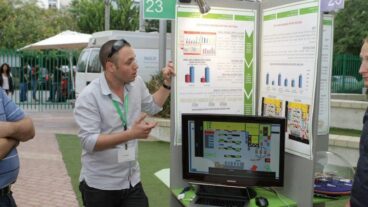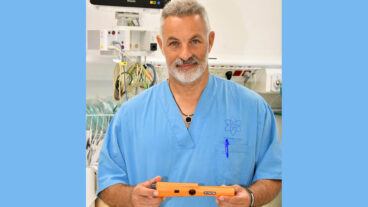The histrelin implant is being touted as a replacement for the current method to curb central precocious puberty – uncomfortable monthly injections.Teenage years can be difficult enough without having them arrive early. Unfortunately, due to a condition called central precocious puberty (CPP), a small percentage of girls enter puberty far earlier than the average – sometimes at seven or eight years of age – before they’re ready to stop growing and reach sexual maturation. Precocious puberty may also present in children as young as two years of age.
Fortunately, a group of Israeli researchers have successfully tested an implant which impedes the early onset of puberty. The implant containing histrelin, a potent agonist of the gonadotropin-releasing hormone which brings on puberty, is being touted as a replacement for the current method to curb CPP – uncomfortable monthly injections.
The study of 11 girls conducted by Dr. Irving Spitz and his colleagues from the Sha’are Zedek Medical Center’s Institute of Hormone Research in Jerusalem was published in the prestigious medical journal Pediatrics.
“The implant is a promising new technique for treating central precocious puberty without the pain and inconvenience of monthly injections,” Spitz told ISRAEL21c.
The implants are based on implants developed over a decade ago by Spitz and a group of researchers at the Population Council, and the American pharmaceutical company, Valera Pharmaceuticals. A similar implant has recently been commercialized by Valera, and used to successfully treat prostate cancer.
“From those good results, we decided to look into the area of precocious puberty to see if the implants could help,” said Spitz, who is also a consultant to Valera.
Spitz’s team at Sha’are Zedek – which included Dr. Harry Hirsch, a specialist in pediatric endocrinology in the department of pediatrics – investigated whether a histrelin implant would suppress gonadotropins and estradiol, hormones that bring on puberty and menstruation, in 11 girls with central precocious puberty for 12 months. They then compared the suppression to standard treatment.
“The girls had all been pre-treated with standard injections in the past, because we wanted to compare the previous treatment with the new implant,” Spitz said. “It’s been well documented that these hormones which cause the onset of puberty can be suppressed by injections of a GnRH agonist. As a consequence, there’s no gonadal activity and the patients revert to pre-pubertal status,” Spitz said.
“This method is well accepted in relation to prostate cancer – where treatment suppresses gonadotropins (and their particular function remove), and it’s also been used in precocious puberty – premature sexual development. The usual treatment for prostate cancer is via monthly injections. Recently a formulation has been developed which can be given at tri-monthly intervals.”
According to Spitz, the results of the implant testing for puberty were encouraging. Puberty hormones remained suppressed at nine months after implant insertion in all 11 girls, and up to 15 months in six girls who were followed for more than one year after the original implant was inserted. All the girls reported less pain and discomfort, and less interference with school activity and work with the implant than with standard monthly injections, the investigators reported.
According to the Pediatrics report, there was no menstrual bleeding during the implant treatment, and mean breast development regressed somewhat during treatment. The acceleration in bone maturation that would signal an end to growth in height decreased during treatment, as did growth velocity, the report indicated.
“Our results showed there were no half measures. Each and every child experienced complete and full suppression. It was even more effective than monthly injections,” said Spitz.
“The advantage of the implant is that it’s simple to insert under local anesthesia and causes the complete suppression of the hormones for one year,” said Spitz. “It obviates the need for children to come in every month for an injection. With injections, kids who have an overactive pituitary gland sometimes even need to come in two or three times a month. And sometimes, these injections are very painful.
“The real benefit is to the children – they don’t have to come back for frequent injections. This means the parents are happier, they don’t have to miss work, and the kids don’t have to miss school.”
As a result of Spitz’s study, Valera Pharmaceuticals is currently conducting a Phase III study of the implant in the US, with intentions of a future filing of a New Drug Application with the FDA for treating central precocious puberty.
“The aim of our study was proof of principle,” said Spitz.
Spitz and his team are continuing to follow the patients and are studying the normal hormone recovery following implant removal at the completion of the course of treatment.
“We’re investigating how rapidly the pituitary and gonadal functions return upon removal of the implant. Our initial markers tell us that it appears to be pretty rapid,” said Spitz.
Matthew Rue, III, Valera’s Vice President of Marketing and Commercial Development had nothing but praise for Spitz and his team.
“The Israeli researchers were enthusiastic and creative. They even came up with some interesting and novel ways of measuring a patient’s return
to normalized hormone levels once the therapy has been discontinued,” he told ISRAEL21c.
Spitz, originally from South Africa, moved to Israel in 1970. He’s been associated with Hadassah Medical Center and Sha’are Zedek where he headed the Institute of Hormone Research. He is a professor of endocrinology at Ben Gurion University of the Negev and also a professor of medicine at the Weill Medical College of Cornell University in New York.
He spent most of the 80s and 90s in New York at the Population Council, Rockefeller University and the Weill Medical College of Cornell University where he was part of the team that developed the histrelin implant. Now officially retired, Spitz still conducts research at Sha’are Zedek and consults for several major pharmaceutical companies, biomedical startups and investment companies.
“Spitz was one of the pioneers in developing the implant. He approached us to be involved in the study,” said his Sha’are Zedek colleague Hirsch.
According to Hirsch, it’s difficult to ascertain how many girls are subject to precocious puberty because the definition of puberty is constantly changing. (Incidence of precocious puberty has been reported to be as low as 1:2000 and as high as 1:160 depending on the definition of age of normal puberty onset as well as other variables, such as ethnicity and country.)
“There’s a controversy about the lower age limit for which puberty onset should be considered to be normal. The usual definitions are age 8 years for girls and 9 years for boys. The rate of precocious puberty does seem to be increasing – and there are theories it’s associated with childhood obesity,” he told ISRAEL21c. Early onset of puberty in girls may be associated with detrimental long-term psychological effects and poor school performance.
“In general, children are reaching puberty at an earlier age – whether due to improved nutrition, over-nutrition or environmental factors. A lot of research is being done in those areas now.”












